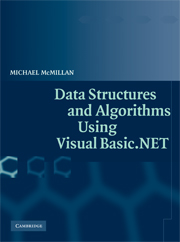Book contents
- Frontmatter
- Contents
- Preface
- Introduction
- Chapter 1 Collections
- Chapter 2 Arrays and ArrayLists
- Chapter 3 Basic Sorting Algorithms
- Chapter 4 Basic Searching Algorithms
- Chapter 5 Stacks and Queues
- Chapter 6 The BitArray Class
- Chapter 7 Strings, the String Class, and the StringBuilder Class
- Chapter 8 Pattern Matching and Text Processing
- Chapter 9 Building Dictionaries: The DictionaryBase Class and the SortedList Class
- Chapter 10 Hashing and the HashTable Class
- Chapter 11 Linked Lists
- Chapter 12 Binary Trees and Binary Search Trees
- Chapter 13 Sets
- Chapter 14 Advanced Sorting Algorithms
- Chapter 15 Advanced Data Structures and Algorithms for Searching
- Chapter 16 Graphs and Graph Algorithms
- Chapter 17 Advanced Algorithms
- References
- Index
Chapter 6 - The BitArray Class
Published online by Cambridge University Press: 11 August 2009
- Frontmatter
- Contents
- Preface
- Introduction
- Chapter 1 Collections
- Chapter 2 Arrays and ArrayLists
- Chapter 3 Basic Sorting Algorithms
- Chapter 4 Basic Searching Algorithms
- Chapter 5 Stacks and Queues
- Chapter 6 The BitArray Class
- Chapter 7 Strings, the String Class, and the StringBuilder Class
- Chapter 8 Pattern Matching and Text Processing
- Chapter 9 Building Dictionaries: The DictionaryBase Class and the SortedList Class
- Chapter 10 Hashing and the HashTable Class
- Chapter 11 Linked Lists
- Chapter 12 Binary Trees and Binary Search Trees
- Chapter 13 Sets
- Chapter 14 Advanced Sorting Algorithms
- Chapter 15 Advanced Data Structures and Algorithms for Searching
- Chapter 16 Graphs and Graph Algorithms
- Chapter 17 Advanced Algorithms
- References
- Index
Summary
The BitArray class is used to represent sets of bits in a compact fashion. Bit sets can be stored in regular arrays, but we can create more efficient programs if we use data structures specifically designed for bit sets. In this chapter we'll look at how to use this data structure and examine some problems that can be solved using sets of bits.
Since many VB.NET programmers have not been properly introduced to working with binary numbers, this chapter also includes a review of binary numbers, bitwise operators, and bitshift operators.
A MOTIVATING PROBLEM
Let's look at a problem we will eventually solve using the BitArray class. The problem involves finding prime numbers. An ancient method, discovered by the third-century b.c. Greek philosopher Eratosthenes, is called the sieve of Eratosthenes. This method involves filtering numbers that are multiples of other numbers, until the only numbers left are primes. For example, let's determine the prime numbers in the set of the first 100 integers. We start with 2, which is the first prime. We move through the set removing all numbers that are multiples of 2. Then we move to 3, which is the next prime. We move through the set again, removing all numbers that are multiples of 3. Then we move to 5, and so on. When we are finished, all that will be left are prime numbers.
We'll first solve this problem using a regular array.
- Type
- Chapter
- Information
- Data Structures and Algorithms Using Visual Basic.NET , pp. 124 - 149Publisher: Cambridge University PressPrint publication year: 2005



